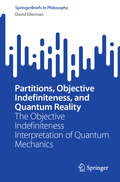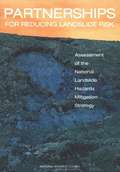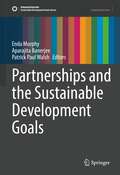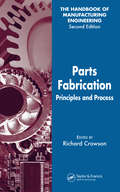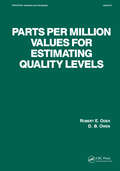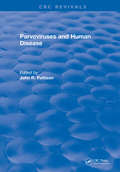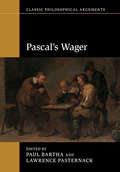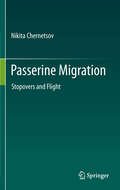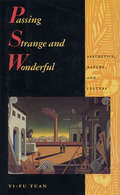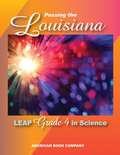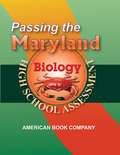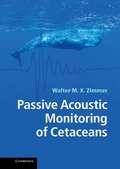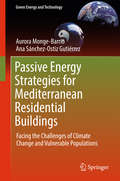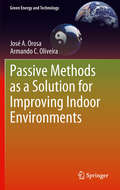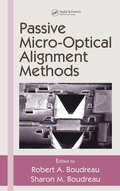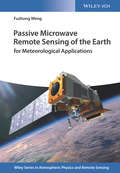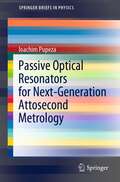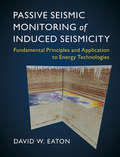- Table View
- List View
Partitions, Objective Indefiniteness, and Quantum Reality: The Objective Indefiniteness Interpretation of Quantum Mechanics (SpringerBriefs in Philosophy)
by David EllermanThis book presents a new ‘partitional' approach to understanding or interpreting the math of standard quantum mechanics (QM). The thesis is that the mathematics (not the physics) of QM is the Hilbert space version of the math of partitions on a set and, conversely, the math of partitions is a skeletonized set level version of the math of QM. Since at the set level, partitions are the mathematical tool to represent distinctions and indistinctions (or definiteness and indefiniteness), this approach shows how to interpret the key non-classical QM notion of superposition in terms of (objective) indefiniteness between definite alternatives (as opposed to seeing it as the sum of ‘waves'). Thus, the book develops a new mathematical, or indeed, logical, approach to the century-old problem of interpreting quantum mechanics, ensure it is of interest to philosophers of science as well as mathematicians and physicists.
Partners in Science: Foundations and Natural Scientists, 1900-1945
by Robert E. KohlerRobert Kohler shows exactly how entrepreneurial academic scientists became intimate "partners in science" with the officers of the large foundations created by John D. Rockefeller and Andrew Carnegie, and in so doing tells a fascinating story of how the modern system of grant-getting and grant-giving evolved, and how this funding process has changed the way laboratory scientists make their careers and do their work. "This book is a rich historical tapestry of people, institutions and scientific ideas. It will stand for a long time as a source of precise and detailed information about an important aspect of the scientific enterprise. . .It also contains many valuable lessons for the coming years."—John Ziman, Times Higher Education Supplement
Partners in Science: Foundations and Natural Scientists, 1900-1945
by Robert E. KohlerRobert Kohler shows exactly how entrepreneurial academic scientists became intimate "partners in science" with the officers of the large foundations created by John D. Rockefeller and Andrew Carnegie, and in so doing tells a fascinating story of how the modern system of grant-getting and grant-giving evolved, and how this funding process has changed the way laboratory scientists make their careers and do their work. "This book is a rich historical tapestry of people, institutions and scientific ideas. It will stand for a long time as a source of precise and detailed information about an important aspect of the scientific enterprise. . .It also contains many valuable lessons for the coming years."—John Ziman, Times Higher Education Supplement
Partnerships For Reducing Landslide Risk: Assessment of the National Landslide Hazards Mitigation Strategy
by Committee on the Review of the National Landslide Hazards Mitigation StrategyLandslides occur in all geographic regions of the nation in response to a wide range of conditions and triggering processes that include storms, earthquakes, and human activities. Landslides in the United States result in an estimated average of 25 to 50 deaths annually and cost $1 to 3 billion per year. In addition to direct losses, landslides also cause significant environmental damage and societal disruption. This report reviews the U.S. Geological Survey’s (USGS) National Landslide Hazards Mitigation Strategy, which was created in response to a congressional directive for a national approach to reducing losses from landslides. Components of the strategy include basic research activities, improved public policy measures, and enhanced mitigation of landslides.The NRC report commends the USGS for creating a national approach based on partnerships with federal, state, local, and non-governmental entities, and finds that the plan components are the essential elements of a national strategy. The report recommends that the plan should promote the use of risk analysis techniques, and should play a vital role in evaluating methods, setting standards, and advancing procedures and guidelines for landslide hazard maps and assessments. The NRC panel suggests that substantially increased funding will be required to implement a national landslide mitigation program, and that as part of a 10-year program the funding mix should transition from research and guideline development to partnership-based implementation of loss reduction measures.
Partnerships and the Sustainable Development Goals (Sustainable Development Goals Series)
by Enda Murphy Aparajita Banerjee Patrick Paul WalshThis volume fills a significant gap in the scientific and policy literature on the Sustainable Development Goals (SDGs) and on SDG 17 which focuses on partnership as a means of implementation (MOI) for the SDGs. The collection offers a strong theoretical context, and outlines the nature of partnerships (e.g. alternative forms, multi-level forms, barriers to take-up) using the most recent UN database as well as through key case studies that highlight partnership successes and failures at local, national and global scales. The text covers a brief history and background of partnerships and the SDGs, an analysis of existing SDG partnership using UN data, a scalar analysis of case studies involving multi-stakeholder partnerships, and recommendations for successful partnership models and implementation strategies. The book will be relevant for a wide variety of readerships including academics in different policy fields and disciplines, policymakers, SDG advocates and practitioners, and NGOs active in the promotion of the SDGs and environmental issues. Provides a unique outline of partnership theory and its application to the SDGs Outlines the nature of partnerships, including their multi-level forms and barriers to take-up using UN data Analyzes key SDG partnerships case studies that highlight partnership success stories for practitioners
Parts Fabrication: Principles and Process
by Richard CrowsonToday's fast-paced manufacturing culture demands a handbook that provides how-to, no-holds-barred, no-frills information. Completely revised and updated, the Handbook of Manufacturing Engineering is now presented in four volumes. Keeping the same general format as the first edition, this latest edition not only provides more information but makes i
Parts per Million Values for Estimating Quality Levels (Statistics: A Series of Textbooks and Monographs)
by R. E. OdehThis book is an extension of some tables from Odeh and Owen, Volume 32 of the Marcel Dekker, Inc., series Statistics: Textbooks and Monographs. The need for these tables was pointed out to us by Dr. James M. Maynard, who worked with the Parts Per Million Subcommittee.
Parvoviruses and Human Disease
by J. R. PattisonThis book gives details of the discovery and research work on B19 virus to date. The virus is an autonomous parvovirus and many of its properties and much of its behaviour can be predicted from this. Accordingly, the detailed account of B19 viruses is set in the context of two general chapters on the nature of parvoviruses and the patterns of disease in animals produced by parvoviruses.
Pascal's Wager (Classic Philosophical Arguments)
by Paul Bartha Lawrence PasternackIn his famous Wager, Blaise Pascal (1623–62) offers the reader an argument that it is rational to strive to believe in God. Philosophical debates about this classic argument have continued until our own times. This volume provides a comprehensive examination of Pascal's Wager, including its theological framework, its place in the history of philosophy, and its importance to contemporary decision theory. The volume starts with a valuable primer on infinity and decision theory for students and non-specialists. A sequence of chapters then examines topics including the Wager's underlying theology, its influence on later philosophical figures, and contemporary analyses of the Wager including Alan Hájek's challenge to its validity, the many gods objection, and the ethics of belief. The final five chapters explore various ways in which the Wager has inspired contemporary decision theory, including questions related to infinite utility, imprecise probabilities, and infinitesimals.
Pashchatya Rog Chikitsa Khand 2: पाश्चात्य रोग चिकित्सा खंड २
by Dr G. E. Bommaडॉ. जी. ई. बोमाँ लिखित “Medicine: Essentials For Practitioners and Students” या ग्रंथाचा मराठी अनुवाद डॉ. मधुकर रानडे, मुंबई यांनी ग्रंथविषयाची माहिती मूळ ग्रंथकाराप्रमाणेच देऊन पण मराठी भाषेच्या प्रकृतीशी मेळ बसेल अशारीतीने केला आहे. तसेच डॉ. बोमाँ यांच्या मूळ ग्रंथातील मूलभूत वैद्यकविज्ञान मराठी भाषांतरात कायम ठेवले असून भारतीय संदर्भात मूळ ग्रंथाचा विषय नीट स्पष्ट करण्यासाठी डॉ. रानडे यांनी, मूळ प्रकाशकांच्या परवानगीने, सदर भाषांतरात आवश्यक ते बदल केले आहेत.
Passages of History
by Beatriz MaestroIs the castle of Trevejo the living vestige that confirms the mythical relationship between Templars and Masons? What were the Civil War and the post-war periods like in Acebo? Was the horrible crime between families that took place in San Martín de Trevejo fair? Who were those persecuted by the Holy Office in Perales and Hoyos? The answers to these questions, and others, are revealed throughout the successive passages that make up this work, where the reader can immerse himself in the past, crossing the frontier of time. This new work by B. Maestro is the story of those who suffered from unemployment and the bad conditions of an iniquitous life, but it is also the story of those who revealed themselves and fought so that this circumstance would change, without forgetting those who defended the democratic government in its day, even when they were the ones who put an end to it. In the pages that make up this work of historical research, the reader will be able to immerse himself fully in a turbulent Contemporary Age, covering its totality, and dividing the chapters following the order of the centuries that conform it (XVIII, XIX and XX).
Passerine Migration
by Nikita ChernetsovMost birds cannot cover the distance between their breeding and winter quarters in one hop. They have to make multiple flights alternated with stopovers. Which factors govern the birds' decisions to stop, to stop for how long, when to resume flight? What is better - to accumulate much fuel and to make long flights for many hundreds of kilometres, or to travel in small steps? Is it necessary to find habitats similar to the breeding ones or other habitats would do? Are long migratory flights indeed so costly energetically as usually assumed? This monograph summarizes our current knowledge on the ecology of songbird migrants during migratory stopovers and on their behaviour.
Passing Strange and Wonderful: Aesthetics Nature And Culture
by Yi-Fu TuanIn this rich and rewarding work, Yi-Fu Tuan vividly demonstrates that feeling and beauty are essential components of life and society. The aesthetic is not merely one aspect of culture but its central core -- both its driving force and its ultimate goal.Beginning with the individual and his physical world, Tuan's exploration progresses from the simple to the complex. His initial evaluation of the building blocks of aesthetic experience (sight, hearing, smell, taste, touch) develops gradually into a wide-ranging examination of the most elaborate of human constructs, including art, architecture, literature, philosophy, music, and more.
Passing Strange: A Gilded Age Tale of Love and Deception Across the Color Line
by Martha A. Sandweiss"Passing Strange" is a uniquely American biography of Clarence King, who hid a secret from his Gilded Age cohorts and prominent family: for 13 years he lived a double life--as the celebrated white explorer, geologist, and writer King and as a black Pullman porter and steelworker named James Todd.
Passing The Louisiana LEAP Grade 4 in Science
by Michelle Gunter Emily PowellPrepare for the Louisiana LEAP Grade 4 in Science test
Passing the Maryland High School Assessment in Biology
by Liz Thompson Michelle GunterPassing the Maryland Biology High School Assessment will help students who are learning or reviewing Core learning goals for the Biology sections of the Maryland High School Assessment Test in Biology. The materials in this book are based on the biology assessment goals, expectations and indicators as published by the Maryland Department of Education.
Passions and Tempers: A History of the Humours
by Noga Arikha“Passions and Tempers may excite passions and tempers in some of its readers, as a good work of intellectual history should. You will learn a lot from its pages.” —Washington PostThe humours—blood, phlegm, black bile, and choler—were substances thought to circulate within the body and determine a person’s health, mood, and character. The theory of humours remained an inexact but powerful tool for centuries, surviving scientific changes and offering clarity to physicians. This one-of-a-kind book follows the fate of these variable and invisible fluids from their Western origin in ancient Greece to their present-day versions. It traces their persistence from medical guidebooks of the past to current health fads, from the testimonies of medical doctors to the theories of scientists, physicians, and philosophers. By intertwining the histories of medicine, science, psychology, and philosophy, Noga Arikha revisits and revises how we think about all aspects of our physical, mental, and emotional selves.
Passions for Birds: Science, Sentiment, and Sport
by Sean NixonWhether as sources of joy and pleasure to be fed, counted, and watched, as objects of sport to be hunted and killed, or as food to be harvested, wild birds evoke strong feelings.Sean Nixon traces the transformation of these human passions for wild birds from the early twentieth century through the 1970s, detailing humans’ close encounters with wild birds in Britain and the wider North Atlantic world. Drawing on a rich range of written sources, Passions for Birds reveals how emotional, subjective, and material attachments to wild birds were forged through a period of pronounced social and cultural change. Nixon demonstrates how, for all their differences, new traditions in birdwatching and conservation, field sports, and bird harvesting mobilized remarkably similar feelings towards birds. Striking similarities also emerged in the material forms that each of these practices used to bring birds closer to people – hides and traps, nets and ropes, and binoculars.Wide ranging in scope, Passions for Birds sheds new light on the ways in which wild birds helped shape humans throughout the twentieth century, as well as how birds themselves became burdened with multiple cultural meanings and social anxieties over time.
Passive Acoustic Monitoring of Cetaceans
by Walter ZimmerPassive acoustic monitoring is increasingly used by the scientific community to study, survey and census marine mammals, especially cetaceans, many of which are easier to hear than to see. PAM is also used to support efforts to mitigate potential negative effects of human activities such as ship traffic, military and civilian sonar and offshore exploration. Walter Zimmer provides an integrated approach to PAM, combining physical principles, discussion of technical tools and application-oriented concepts of operations. Additionally, relevant information and tools necessary to assess existing and future PAM systems are presented, with Matlab code used to generate figures and results so readers can reproduce data and modify code to analyse the impact of changes. This allows the principles to be studied whilst discovering potential difficulties and side effects. Aimed at graduate students and researchers, the book provides all information and tools necessary to gain a comprehensive understanding of this interdisciplinary subject.
Passive Energy Strategies for Mediterranean Residential Buildings
by Aurora Monge-Barrio Ana Sánchez-Ostiz GutiérrezThis book presents an approach to energy-efficient building design, which takes into account the most important challenges in climate change mitigation and adaptation in Southern Europe. It outlines a specific approach related to residential buildings and their intergenerational and vulnerable occupants, such as ageing population and users in fuel poverty. It also focuses on the use of passive energy measures throughout the year, and on pursuing a realistic and affordable approach to the efficient rehabilitation of resilient residential buildings.In addition, the book presents case studies that include surveys, monitoring, and simulation of residential buildings in Spain and other Southern European representative locations, in order to go further on the study of this challenging topic.
Passive Methods as a Solution for Improving Indoor Environments
by José A. Orosa Armando C. OliveiraThere are many aspects to consider when evaluating or improving an indoor environment; thermal comfort, energy saving, preservation of materials, hygiene and health are all key aspects which can be improved by passive methods of environmental control. Passive Methods as a Solution for Improving Indoor Environments endeavours to fill the lack of analysis in this area by using over ten years of research to illustrate the effects of methods such as thermal inertia and permeable coverings; for example, the use of permeable coverings is a well known passive method, but its effects and ways to improve indoor environments have been rarely analyzed. Passive Methods as a Solution for Improving Indoor Environments includes both software simulations and laboratory and field studies. Through these, the main parameters that characterize the behavior of internal coverings are defined. Furthermore, a new procedure is explained in depth which can be used to identify the real expected effects of permeable coverings such as energy conservation and local thermal comfort as well as their working periods in controlling indoor environments. This theoretical base is built on by considering future research work including patents and construction indications which will improve indoor environmental conditions with evidence from real data. This makes Passive Methods as a Solution for Improving Indoor Environments an ideal resource for specialists and researchers focusing on indoor air quality, thermal comfort, and energy saving or with a general interest in controlling indoor environments with passive methods.
Passive Micro-Optical Alignment Methods
by Robert A. Boudreau Sharon M. BoudreauThe most expensive phase in the manufacture of micro-optical components and fiber optics is also one of the most performance-critical: optical alignment of the components. The increasing degree of miniaturization makes this an especially challenging task. Active alignment methods result in higher costs and awkward processes, and for some applications, they simply are not possible. Passive Micro-Optical Alignment Methods introduces the passive alignment methods that are currently available and illustrates them with many examples, references, and critiques.The first book dedicated to passive alignment, it begins with an overview of the current activities, requirements, and general results of passive optical alignments, followed by three sections of in-depth analysis. The first of these discusses mechanical passive alignment, highlighting silicon waferboard, solder, and "Jitney" technologies as well as application of mechanical alignment to 3D free-space interconnects. The next section describes the various visual alignment techniques applied to Planar Lightwave Circuits (PLCs) and low-cost plastic and surface mount packaging. The final section details various utilities that aid passive alignment and their resulting tradeoffs and demonstrates Monte Carlo analysis to evaluate the potential of a given method.Passive Micro-Optical Alignment Methods provides the tools necessary to meet the challenge of precision and low-cost alignment for applications that require micron or sub-micron tolerance.
Passive Microwave Remote Sensing of the Earth: for Meteorological Applications
by Fuzhong WengThis book covers the fundamentals of satellite microwave instrument calibration, remote sensing sciences and algorithms, as well as the applications of the satellite microwave observations in weather and climate research.
Passive Optical Resonators for Next-Generation Attosecond Metrology (SpringerBriefs in Physics)
by Ioachim PupezaThis book introduces readers to the development of a new generation of high pulse-repetition frequency instruments for multi-dimensional attosecond-resolution photoelectron spectroscopy (attosecond PES). It investigates the power scaling of femtosecond enhancement cavities for efficient intracavity high-harmonics generation (HHG). Further, it derives and verifies advanced resonator designs that feature large illuminated spots on all mirrors, which mitigate both intensity- and thermally-induced enhancement limitations.The dynamics of a high-finesse, passive resonator in the presence of a highly nonlinear optical process such as HHG are quantitatively investigated, both theoretically and experimentally. These investigations are instrumental in achieving the holistic optimization of the XUV source reported on here, which for the first time reached intracavity HHG conversion efficiencies comparable to those achieved in single-pass setups with a similar gas target.Coupling out the XUV beam from the enhancement cavity by purely geometric means, employing both the fundamental and higher-order transverse Gaussian modes, is studied. This offers the advantages of robustness, low distortion to the participating pulses, and photon-energy scalability. Last but not least, the author provides a range of proof-of-principle attosecond angle-resolved PES experiments.The book gives an outlook on the possible future development of cavity-enhanced HHG and an extensive discussion on the generation of isolated XUV attosecond pulses via intracavity wavefront rotation.
Passive Seismic Monitoring of Induced Seismicity: Fundamental Principles And Application To Energy Technologies
by David W. EatonThe past few decades have witnessed remarkable growth in the application of passive seismic monitoring to address a range of problems in geoscience and engineering, from large-scale tectonic studies to environmental investigations. Passive seismic methods are increasingly being used for surveillance of massive, multi-stage hydraulic fracturing and development of enhanced geothermal systems. The theoretical framework and techniques used in this emerging area draw on various established fields, such as earthquake seismology, exploration geophysics and rock mechanics. <P><P>Based on university and industry courses developed by the author, this book reviews all the relevant research and technology to provide an introduction to the principles and applications of passive seismic monitoring. It integrates up-to-date case studies and interactive online exercises, making it a comprehensive and accessible resource for advanced students and researchers in geophysics and engineering, as well as industry practitioners.<P> Presents real field data demonstrating how passive seismic monitoring works in practice.<P> Interactive online problems are provided, enabling readers to test their knowledge and understanding.<P> Provides an interdisciplinary overview of the topic combining fundamental and applied elements.
